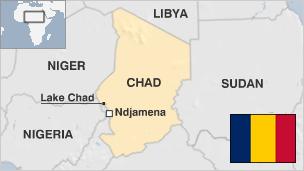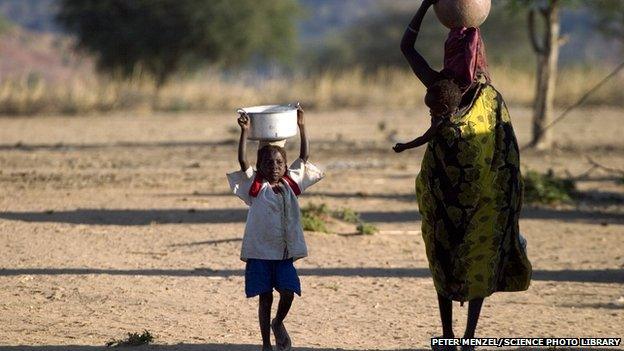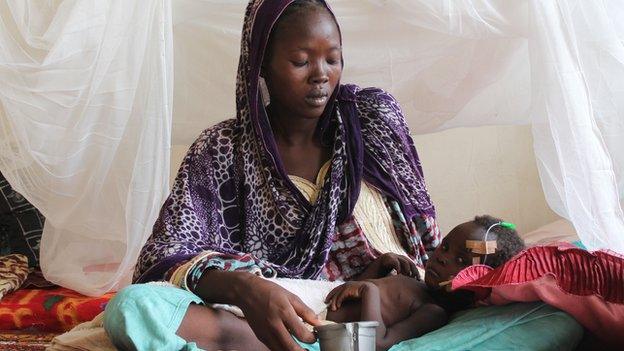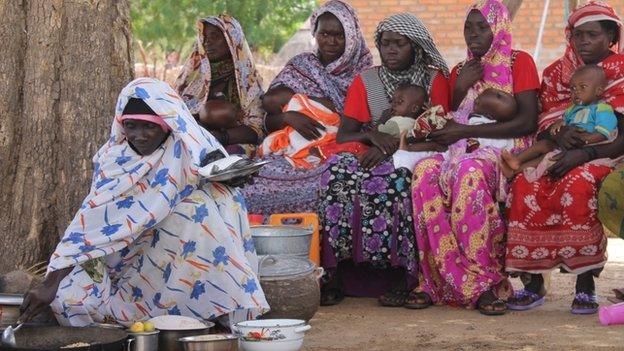Building a better future for Chad
- Published
Fergus Walsh visits a UNICEF nutrition centre in Chad
On every global measure of poverty, health or economic development, Chad is near the bottom, external.
This landlocked country in central Africa has a harsh climate, suffering both drought and flooding - food shortages are common.
Its people have endured decades of corruption, external, civil unrest and mass influxes of refugees from neighbouring states like Sudan and Nigeria.
Chad is a potent symbol of what work is still needed to eradicate extreme poverty and hunger - the first of the eight Millennium Development Goals, external (MDGs).
Poverty
The target - to halve the proportion of people whose income is less than $1.25 (£0.80) a day was met five years ahead of schedule in 2010.
But this was a global, rather than a national target and China's extraordinary growth accounts for a significant part of that.
The Sub-Saharan region of Africa has made progress, cutting poverty rates by 35%, but millions here risk being left behind.

They include people like Bami, aged 50, who has nine children and lives near the town of Mongo.
When I met him he was out with his family, breaking holes in the parched earth with a hoe, while his family walked behind him planting millet seeds.
It looked like back-breaking work, and with temperatures rising well above 40C, progress was slow.
If it doesn't rain, his family will go hungry - he told me his dream was to own a plough.
This is a basic example of how to help take a family out of poverty - a plough enables them to grow food to sell or to stockpile.
Six out of 10 people in Chad live in extreme poverty and it will require major investment in agriculture, education and infrastructure if that is to change.
Rapid population growth is adding to the pressures on a fragile and underdeveloped healthcare system.
The population of 12.5m has doubled since 1990 and is set to double again by 2040, external.
Hungry mouths

Growing up in Mongo: What's it like to live in one of the world's poorest towns?, external
Malnutrition is the most pernicious consequence of poverty.
It is the failure to get adequate healthy food to lead a normal, productive life.
Malnutrition makes individuals more susceptible to infection and ill health and is a significant factor in nearly half of all child deaths globally.
From conception to a child's second birthday is the most crucial period of cognitive and physical development.
Pregnant mothers who are malnourished are more likely to give birth to low-weight babies who risk dying in the first weeks of life.
Chronic malnourishment in young children puts them at risk of stunted growth or "stunting".
This is an irreversible condition where the body and brain never fully develop; it means children are less likely to do well at school or get good employment.
One in four of the world's children is stunted, so it has an impact not just on individuals but on whole economies.
In Chad, rates of stunting are even higher.
So what is being done?
Quick fixes
The immediate priority of health teams here is to target the most severely malnourished children - those whose lives are in immediate danger.
There are now 500 nutrition centres across Chad, double the number four years ago.
Unicef has helped fund the expansion as well as paying for the training of health workers and for vaccination programmes, along with aid partners such as the International Rescue Committee.
At the under-fives nutrition centre in Mongo, which is part of the town hospital, babies receive fortified milk while older children are given sachets of a peanut paste.
These are short-term fixes, but they can save many lives.

Zenaba and her son, Noura, before starting treatment
Zenaba Zakaclia, aged 19, brought her son to the hospital a week ago.
Noura Adef, who's almost two, had measles and was severely malnourished.
He had no energy and spent his time lying on the bed or in his mother's lap.
In just four days I could see that his condition had dramatically improved and once his measles infection is cleared he will be able to return home.
Efforts are also being made to help families deal with chronic malnutrition, where children may not appear physically ill or hungry, but they are not thriving.
Breastfeeding for the first six months of life helps build the immune system and it is the best defence against infant malnutrition.
But only 3% of Chad's children are exclusively breastfed - one of the lowest rates in Africa.
The health centres also organise cooking demonstrations for new mothers, teaching them the nutritional values of different locally available ingredients.

Mothers get a cooking skills lesson from Halime Zakarie, who lost a son to malnutrition
One in six children in Chad die before the age of five, the third highest rate globally, behind Sierra Leone and Angola.
One in 15 women will die in childbirth.
In September, the UN General Assembly will vote on the introduction of the Sustainable Development Goals (SDGs), the global targets that will replace the MDGs from next year.
Unicef's spokesman in Chad, Manuel Moreno, told me there had been some progress within the country, but much more was yet to be done.
"Millions of children in countries like Chad risk being left behind.
"We have to ensure that we reach the most vulnerable and the poorest, otherwise we will be failing future generations.
"That means providing quality education and health services which are accessible.
"The MDGs show that the issues of extreme poverty and hunger can be addressed - we simply need to be more ambitious."
Instead of eight goals and 21 targets, the SDGs are vast: 17 goals and 169 targets and shift from trying to address the effects of poverty to targeting its root causes.
UK Prime Minister David Cameron said last September that there were too many targets to communicate effectively and they risked "sitting on a bookshelf gathering dust".
But Unicef is pleased that the SDGs will address key issues not covered by the MDGs, including ending child marriage and violence against children.
The BBC's Fergus Walsh reports from one of the world's poorest nations, Chad in central Africa
- Published2 July 2015
- Published2 June 2015